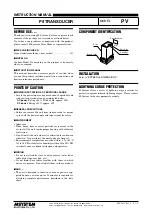
Squelch Setup
Before turning on the transceiver for the first time:
O Preset the VOL and SQL controls fully counter-clockwise.
O Then press the POWER button (if the transceiver is off) and adjust the VOL control for
comfortable volume on the noise or any received signal. "BUSY" should be displayed in
reverse letters at the far left.
O If you hear a signal, turn the selector knob to a clear channel (only noise).
O Turn the SQL knob clockwise just to silence the noise. The "BUSY" indicator will disap-
pear. Setting the SQL further clockwise reduces sensitivity to weak signáis. Whenever a
signal reaches the receiver that is strong enough to open the squelch, "BUSY" will be
displayed.
Note that while receiving, one or more bar-graph segments may appear at the lower left
córner of the display, indicating signal strength of received signáis. This is not affected by
the squelch setting, so even squelched signáis can give some indication. If more than two
bar-graph segments appear while the squelch is closed, try reducing the squelch control
setting (if you want to hear weak signáis).
Frequency Selection Modes
Dial Mode
This mode is for tuning or scanning the band when looking for a channel on which to
operate, when you don't have a specific frequency in mind. In this mode, the selector knob
and mi-crophone buttons each tune the band in the selected step size, or in 1-MHz steps, and
the scanning function tunes in the selected step size.
Memory Mode
This mode is mainly for operating only on specific frequency channels known in advance
(and programmed into the memories). For ex-ample, after storing the frequencies of your lo-
cal repeaters into memories, you can confine operation to those channels by selecting the
memory mode. In this mode, the selector knob, microphone buttons and scanning function
se-lect sequentially from the stored memories. The FT-2400H gives you 31 memories, each
of which can store repeater shift and direction, CTCSS settings, and sepárate receive and
transmit frequencies. There is also a Memory Tune mode, in which you can tune just like the
dial mode, and store the resulting retuned memory into the same or another memory. This
and other special memory mode functions are described later, but you will want to keep these
terms in mind.
You can tell at a glance which channelling mode is in by looking in the shaded memory box
above and to the left of the frequency display. If the box is empty, you are in the dial mode.
If you see a number or an "/.", "U" or "C" in the box, you are in the memory mode.
The D / MR button near the top right córner of the display (and the button on the front of the
MH- 27A8J microphone) toggles between the dial and memory modes. While in the memory
mode, your previous dial mode selections are preserved. Also, when you switch from the dial
to the memory mode, the last-selected memory is recalled.
Frequency & Step Selection
You can select a new operating frequency from either the dial mode or by retuning a
memory. For now, we suggest using the dial mode. If you see a memory number in the mem-
ory box, press the D / MR button to switch to dial
mode. There are two ways to select your operating frequency: by the selector knob, or with
the microphone buttons. However, holding one of the microphone buttons for more than ½
second starts the scanner. This is described later, but if you've already started it, just press a
microphone button again to stop.
To select the MHz range in which you wish to opérate: first press the MHZ PRI button above
the selector knob so that the kHz digits are blanked, and then turn the knob. To return to
normal tuning and display, just wait five sec-onds, or press MHZ PRI again to redisplay the
kHz digits, and then turn the selector knob.
Locked Controls
If nothing happens when you press a button or turn the selector knob, the controls may be
locked. Check for "LOCK" at the top leñ córner of the display, and if you see it, press F/W
—> LOW LOCK to unlock the controls. Later you will want to enable the lock (with the
same button sequence) to prevent having your settings disturbed. Pressing buttons while
locked sounds different musical notes for as long as a button is held, but only the unlocking
sequence affects operation.
Default channel (tuning) steps are 5 kHz in versión A, and 12.5 kHz in versión B (for
Europe). To select another step size, press F/W—» A/N STEP, turn the selector knob for the
desired steps, and press A/N STEP again. See the box above if the buttons or knob fail to
opérate.
Transmitting
Press the D / MR button at the upper right, several times, if necessary, to select low power
output. The display will return to normal after a few seconds, and "LOW" is displayed to the
left of the memory box (when either low or médium power is selected). When you wish to
transmit, wait until the channel is clear ("BUSY" not displayed), and squeeze the PTT switch
on the microphone while talking across the front of it. During transmission, "TX" appears at
the left side of the display, and the S&PO bargraph shows relative transmitter power output
(4 segments for low power, 8 for medium, and full-scale for high). Release the PTT switch to
receive.
If you require more power press the LOW LOCK button again (to switch to medium or high
power). However, we recommend using low power whenever possible to minimize possible
inter-ference, current consumption and heating.
If using a European versión, press the button on the front of the microphone to transmit a
1750-Hz Burst Tone to access repeaters that require it.
6
Содержание FT-2400H
Страница 1: ......
































